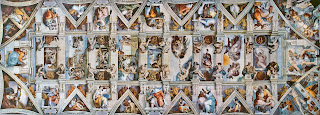In class we
read Lakoff and Johnson in order to further understand metaphorical language, but
when applying these theories and patterns to ceilings things can get a bit
complicated. Good is traditionally
associated with up and inversely bad is associated with down, but this can
change when taking into account that all of these constructs are orientational
metaphors rooted in our physical and cultural experiences. Contradictions emerge when it is realized
that even though something may be above us physically it can still be under
something else, so up is not always an absolute.
As Lakoff
and Johnson explain, “having control or force is up; being subject to control
or force is down” (50) so, having control over someone puts them under your
control. Similarly, being under someone’s
control means that they have control over you.
In this flipped instance, dependent upon the position of you, these
things are good when you are above them but bad when they are above you. So can’t we look at being under something as
the same thing as looking up at something?
This is where the ceiling comes in.
Lakoff and Johnson deduct that happy is up, good is up, the future is
up, etc. but when something that is up is also limiting how do things change? Interestingly enough, ceiling and sealing are
homophones, and that single relationship is quite telling of what the ceiling
is usually perceived to be: a limit.
When we are in a room the ceiling is what is up, it is the lid on top of the box we are in, but because buildings
are constructs just as language is, we know from experience that the ceiling is
only up temporally. Once we leave the room there are new ups that are higher
than the ceiling. So, couldn’t one
possibly make the argument then that the furthest stars in space, though they
might be up, are not as free as we say them to be, that they too could be under
something that is just beyond our ability to perceive? Possibly. However, until we find out (if we ever do) we will still regard our “uppest” up,
thus far, as a beautiful, good thing.
Now, in
applying these thoughts to art, we must look back in time rather than forward,
and we mustn’t forget about the ceiling!
Economists may have the stress of the debt ceiling, minorities may have
the oppression of the glass ceiling, but, traditionally, artists have made
their own ceilings that are much more enjoyable than those mentioned
before. Let us begin with Michaelangelo:
Image courtesy of Wikipedia's Sistine Chapel page
Here is a link to an amazing interactive 3D view of the Sistine Chapel:
http://www.vatican.va/various/cappelle/sistina_vr/
Arguably one of the most important things to happen in the art world (ever) is Michaelangelo's masterpiece that is the Sistine Chapel ceiling. The ceiling includes nine stories form the book of Genesis, the ancestors of Christ, and alternating male and female prophets with Jonah over the altar amounting to more than 300 figures in total. The ceiling illustrates the creation, Adam and Eve in Eden and the Great Flood. Although it is a ceiling, a limit, it has been transformed into something much more. As the highest point inside the chapel, a place concerned with heaven and what is holy above us, the ceiling serves as one of the highest homages to God and the biblical story.
Image courtesy of another blogger: http://blog.wandr.me/2015/06/calm-tokyo-asakusa-neighborhood/looking-up-in-the-senso-ji-temple-some-incredible-paintings-on-the-ceiling/
Another very important ceiling belongs to the Buddhist temple of Senso-ji in Tokyo, Japan. The ceiling consists of various paintings including one of a giant dragon with a globe in its claws and another of Avalokitesvara, the bodhisattva associated with mercy. Bodhisattvas are seen as intermediaries between people and the Buddha who have already reached enlightenment, but have chosen not to move onto Nirvana until they have helped every last person do so before themselves. This ceiling again has become a dedication to the heavenly.
Image courtesy of www.maxineschnitzer.com
The Blue Mosque of Istanbul, Turkey is also home to a very important ceiling. Built in the early 1600's, the mosque combines Ottoman and Byzantine architecture and its ceiling, made from some 20,000 tiles, is said to depict the heavens.
The link between ceilings, the "uppest" up of an interior, and religion, argued by some as the "uppest" up of our lives, is unwavering. With art the ceiling has become somewhat of an artificial sky with heavenly implications throughout the years. A ceiling is able to transform a room-- to suspend disbelief that it is even a room, but instead an all encompassing space existing outside of the laws of architecture and within holy confines instead. Ceilings tell stories, act as offerings and embody varying characteristics of Up that change the way we experience interiors.



No comments:
Post a Comment